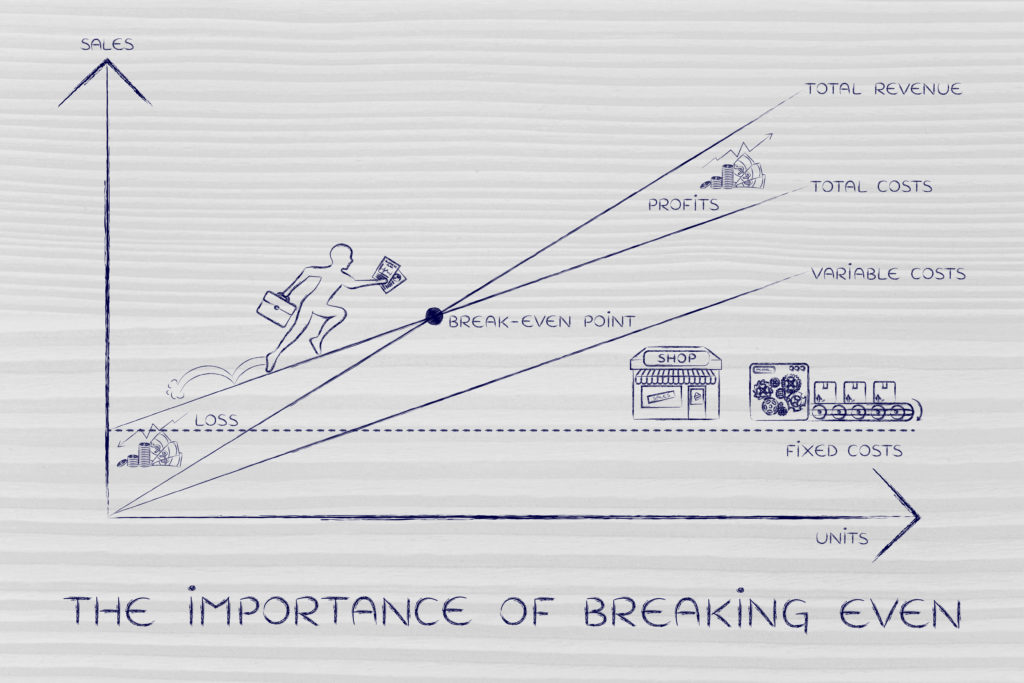How To Unleash Profitability to Mastering the Break-Even Analysis

What is break-even analysis?
Break-even analysis is like a special tool that helps us figure out when a business, service, or product starts making money. It’s like a game where we do some math to see how many things we need to sell to cover all the costs of making those things. Once we sell enough to cover all the costs, everything we sell after that is like a prize, it’s our profit!
To understand break-even analysis, we need to know a few words. One word is “variable costs.” These costs are like the ingredients or materials we need to make our product. Sometimes, these costs change depending on how much we make. For example, if we’re making food, the cost of the ingredients can change if we make a lot or a little.
The other word is “fixed costs.” These costs don’t change no matter how much we make. It’s like the stuff we need to pay for even if we don’t make anything. For example, the rent for the place where we work or the insurance we need to protect our business.
By doing a break-even analysis, we can figure out how many things we need to sell to cover all the costs. Once we reach that point, anything we sell after that is extra money in our pockets. So, break-even analysis helps us understand when our business starts making a profit and how much we need to sell to get there!
Why is Break-Even Point Analysis Important?
Break-even point analysis is like a secret tool that helps us make smart decisions about our business. If we don’t use it, we might not have enough information to plan and make important choices about costs, prices, and how much we need to sell.
Let me explain why break-even analysis is important in a simpler way:
-
See Your Liabilities: When we do a break-even analysis, we write down all the things we have to pay for, like rent, bills, and other expenses. This helps us understand how much we need to sell just to cover all these costs.
-
Set Better Prices: Knowing how much we need to sell a product or service is really important. It helps us decide on the right prices so we can pay for all our expenses and still make some money.
-
Understand Fixed Costs: Some costs, like rent and bills, stay the same no matter how much we sell. Break-even analysis helps us figure out how much we need to sell to cover these fixed costs.
-
Make a Profit: Break-even analysis helps us set the right prices and know how many things we need to sell to start making money. It’s like a guide to making a profit!
-
Grow Your Business: When we use break-even analysis and start making profits, it opens up exciting opportunities. We can attract investors, get loans, and make investments to grow our business even more.
So, break-even analysis is like a special tool that helps us make good decisions, set the right prices, make a profit, and grow our business! It’s really important for making our business successful.
When do you need a Break-Even Analysis?
Let’s imagine you’re running a small toy-making business where you create and sell handmade stuffed animals. Here are some examples of when break-even analysis would be helpful:
-
Introducing a New Toy: When you come up with a new stuffed animal design, break-even analysis helps you calculate how many toys you need to sell to cover the costs of materials and labor for making them.
-
Opening a Pop-Up Shop: If you decide to open a temporary shop to sell your stuffed animals at a local fair or event, break-even analysis helps you determine how many toys you need to sell to cover the booth rental fee and other expenses associated with the event.
-
Expanding to Online Sales: Suppose you want to start selling your stuffed animals online in addition to your physical store. Break-even analysis helps you understand how many toys you need to sell online to cover the costs of website development, packaging, and shipping.
-
Making Costly Equipment Purchases: Let’s say you’re thinking of buying a new sewing machine to increase production efficiency. Break-even analysis helps you determine how many extra toys you need to sell to make up for the cost of the new machine.
-
Adjusting Pricing: If you’re considering raising or lowering the prices of your stuffed animals, break-even analysis helps you analyze the impact on your break-even point and profitability. It ensures that your pricing decisions align with your financial goals.
-
Cost Reduction Strategies: Break-even analysis can help you identify areas where you can reduce costs without sacrificing quality. For example, it helps you assess whether sourcing materials from different suppliers or optimizing production processes can lower your break-even point.
Remember, break-even analysis is like a helpful guide that tells you how many toys you need to sell to cover your costs and start making a profit. It’s a great tool for making informed decisions and ensuring the financial success of your toy-making business.
How to calculate a break-even point
Let’s say you have a cupcake business called Sweet Delights. Here are the details:
Fixed Costs:
- Monthly rent: $1,000
- Utilities and other expenses: $500
- Monthly salaries: $1,500
Variable Costs:
- Cost of ingredients, packaging, and decorations per cupcake: $1.50
- Selling price per cupcake: $3.00
Now, let’s calculate the break-even point for Sweet Delights:
Step 1: Add up the fixed costs: $1,000 + $500 + $1,500 = $3,000
Step 2: Subtract the variable cost per unit from the selling price per unit: $3.00 – $1.50 = $1.50
Step 3: Divide the result by the fixed costs: $3,000 ÷ $1.50 = 2,000 cupcakes
The break-even point for Sweet Delights is 2,000 cupcakes. This means that to cover all the fixed costs, such as rent, utilities, and salaries, the business needs to sell at least 2,000 cupcakes.
Anything above this break-even point represents profit. So, if Sweet Delights sells more than 2,000 cupcakes, they will start making a profit.
Example 2:
Let’s consider a handmade jewelry business called Sparkle Designs. Here are the details:
Fixed Costs:
- Monthly studio rent: $800
- Equipment and supplies: $500
- Insurance: $100
- Monthly salaries: $1,200
Variable Costs:
- Cost of materials per piece of jewelry: $5.00
- Selling price per piece of jewelry: $20.00
Now, let’s calculate the break-even point for Sparkle Designs:
Step 1: Add up the fixed costs: $800 + $500 + $100 + $1,200 = $2,600
Step 2: Subtract the variable cost per unit from the selling price per unit: $20.00 – $5.00 = $15.00
Step 3: Divide the result by the fixed costs: $2,600 ÷ $15.00 = 173.33 (rounded to 174 pieces)
The break-even point for Sparkle Designs is approximately 174 pieces of jewelry. This means that to cover all the fixed costs, such as rent, equipment, salaries, and insurance, the business needs to sell at least 174 pieces of jewelry.
If Sparkle Designs sells more than 174 pieces, they will start generating profits. Each additional piece sold beyond the break-even point contributes to the business’s profitability.
How to Do Break-Even Point in Excel?
- Write your data
- Use the formula to subtract selling price and variable cost (remember variable cost and cost of the product is the same, it is called variable costs because the price change according to the production volume). Remember to subtract the cost from the price, not the other way around.
- Now make the division between fixed costs and the subtraction result (price – cost) also called contribution per unit.
Don’t worry about the dollar sign, excel will believe is money. The result is the number of units you need to sell to break even.
Write your data

Use the formula to subtract selling price and variable cost (remember variable cost and cost of the product is the same, it is called variable costs because the price change according to the production volume). Remember to subtract the cost from the price, not the other way around.

Now make the division between fixed costs and the subtraction result (price – cost) also called contribution per unit.

Don’t worry about the dollar sign, excel will believe is money. The result is the number of units you need to sell to break even.


